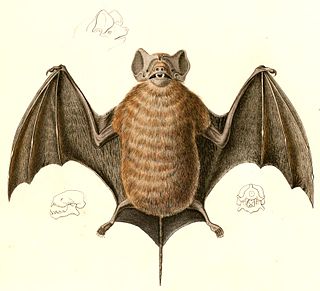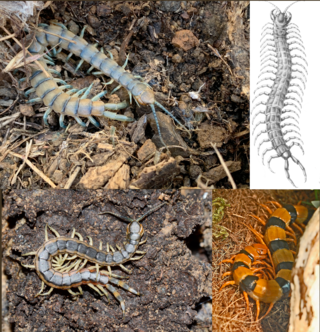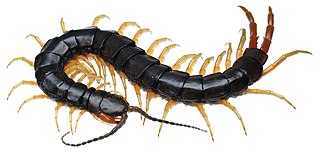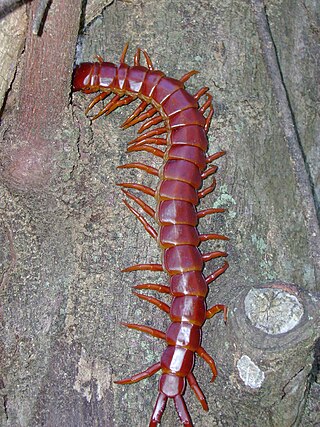
Centipedes are predatory arthropods belonging to the class Chilopoda of the subphylum Myriapoda, an arthropod group which includes millipedes and other multi-legged animals. Centipedes are elongated segmented (metameric) creatures with one pair of legs per body segment. All centipedes are venomous and can inflict painful stings, injecting their venom through pincer-like appendages known as forcipules or toxicognaths, which are actually modified legs instead of fangs. Despite the name, no centipede has exactly 100 pairs of legs; number of legs ranges from 15 pairs to 191 pairs, always an odd number.

Scolopendra heros, commonly known as the Arizona desert centipede, giant desert centipede, giant Sonoran centipede, Texas black-tailed centipede, Texas redheaded centipede, and giant redheaded centipede, is a species of North American centipede found in the Southwestern United States and Northern Mexico.

Scolopendra gigantea, also known as the Peruvian giant yellow-leg centipede or Amazonian giant centipede, is a centipede in the genus Scolopendra. It is the largest centipede species in the world, with a length exceeding 30 centimetres (12 in). Specimens may have 21 or 23 segments. It is found in various places throughout South America and the extreme south Caribbean, where it preys on a wide variety of animals, including other sizable arthropods, amphibians, mammals and reptiles.

The Chinese red-headed centipede, also known as the Chinese red head, is a centipede from East Asia. It averages 20 cm (8 in) in length and lives in damp environments.

The velvety free-tailed bat or Pallas's mastiff bat, is a bat species in the family Molossidae.

Scolopendra subspinipes is a species of very large centipede found throughout southeastern Asia. One of the most widespread and common species in the genus Scolopendra, it is also found on virtually all land areas around and within the Indian Ocean, all of tropical and subtropical Asia from Russia to the islands of Malaysia and Indonesia, Australia, South and Central America, the Caribbean islands, and possibly parts of the southern United States, but how much of this range is natural and how much due to human introduction is unclear. With a wide geographic range and numerous color variations, the species is known by many common names, including jungle centipede, orange-legged centipede, Hawaiian centipede, and Vietnamese centipede.

Scolopendridae is a family of large centipedes.

Scolopendra is a species-rich genus of large tropical centipedes of the family Scolopendridae.

Cormocephalus rubriceps, also known as the Hura or giant centipede, is a large centipede of the family Scolopendridae. It is native to Australia and New Zealand, where it is found in the North Island and on islands off the North Island. At up to 25 cm in length, it is the largest centipede in New Zealand.

Scolopendra polymorpha, the common desert centipede, tiger centipede, banded desert centipede, or Sonoran Desert centipede, is a centipede species found in western North America and the Hawaiian Islands.
S. gigantea may refer to:

Scolopendra morsitans, also known as the Tanzanian blue ringleg or red-headed centipede, is a species of centipede in the family Scolopendridae. S. morsitans is the type species for the genus Scolopendra.

Scolopendra viridicornis is a species of centipede in the family Scolopendridae which can be found within the Amazon rainforest, the type locality being in Brazil. Due to the geographic distribution of this species it is known as the Amazonian giant centipede.

Scolopendra cataracta is a species of centipede in the family Scolopendridae. It is the first known amphibious centipede, growing to up to 20 centimetres (7.9 in) in length.

Scolopendra dehaani, common name Giant Vietnamese centipede, is a large Scolopendrid centipede found across Mainland Southeast Asia. It is also found in India, Japan, Hong Kong, and the Andaman and Nicobar Islands.

Scolopendra japonica, formerly classified as Scolopendra subspinipes japonica, is a species of scolopendrid centipede mostly found in Japan, although specimens have been reported in other parts of Eastern Asia such as China, Taiwan, Myanmar, Cambodia, and Laos. They usually grow between 7.5 and 13 centimetres in length. It is known by the common names Japanese giant centipede and blue-head centipede.

Scolopendra dawydoffi is a species of large Scolopendrid centipede found in Southeast Asia, specifically in Laos, Vietnam, Thailand, and Malaysia. It has bright reddish-orange and black colouration, and can grow up to and beyond 16 cm in length.

Scolopendra galapagoensis, also known as the Galápagos centipede and Darwin's goliath centipede, is species of very large centipede in the family Scolopendridae. It is the only representative of the genus Scolopendra on the Galapagos Islands, among twelve other species of centipede present on the Islands. It is also found on mainland South America in Ecuador and Peru, and on Cocos Island in Costa Rica.

Scolopendra alcyona, known in Japanese as 琉神大百足 and in English as the Halcyon giant centipede, is a species of amphibious centipede found in the Ryukyu Archipelago of Japan and Taiwan. It is the third amphibious member of the genus Scolopendra discovered so far, and the largest species of centipede in Japan, as well as the first new centipede species discovered in Japan for 143 years.

Scolopendra alternans, commonly known as the Haitian giant centipede, Caribbean giant centipede, and Florida Keys centipede, is a species of large centipede in the subfamily Scolopendrinae. The species was involved in widespread news coverage after an incident in John Pennekamp Coral Reef State Park, in which a specimen of the extremely rare rim rock crown snake died of asphyxiation while trying to eat a Scolopendra alternans, which also died.


















